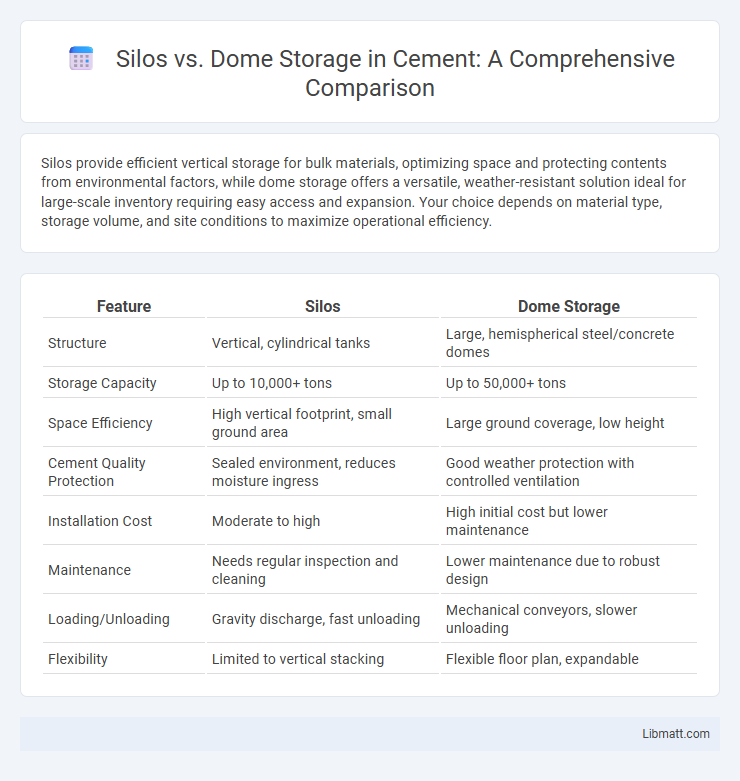Silos provide efficient vertical storage for bulk materials, optimizing space and protecting contents from environmental factors, while dome storage offers a versatile, weather-resistant solution ideal for large-scale inventory requiring easy access and expansion. Your choice depends on material type, storage volume, and site conditions to maximize operational efficiency.
Table of Comparison
| Feature | Silos | Dome Storage |
|---|---|---|
| Structure | Vertical, cylindrical tanks | Large, hemispherical steel/concrete domes |
| Storage Capacity | Up to 10,000+ tons | Up to 50,000+ tons |
| Space Efficiency | High vertical footprint, small ground area | Large ground coverage, low height |
| Cement Quality Protection | Sealed environment, reduces moisture ingress | Good weather protection with controlled ventilation |
| Installation Cost | Moderate to high | High initial cost but lower maintenance |
| Maintenance | Needs regular inspection and cleaning | Lower maintenance due to robust design |
| Loading/Unloading | Gravity discharge, fast unloading | Mechanical conveyors, slower unloading |
| Flexibility | Limited to vertical stacking | Flexible floor plan, expandable |
Introduction to Bulk Material Storage
Bulk material storage encompasses various methods designed to efficiently contain large quantities of raw materials, with silos and dome storage being two prominent options. Silos are typically vertical structures ideal for storing granular materials like grain or cement, offering easy gravity-fed discharge and space efficiency. Dome storage provides a versatile, weather-resistant solution for bulk solids, accommodating irregular shapes and volumes while protecting materials from environmental factors to maintain your product quality.
Overview of Silo Storage Systems
Silo storage systems are vertical cylindrical structures designed primarily for bulk material storage such as grains, cement, and other granular products. These systems enable efficient space utilization and protection from external contaminants by providing airtight, weather-resistant containment. Key features include gravity-fed discharge mechanisms, automated filling and emptying controls, and robust construction materials like steel or reinforced concrete to ensure durability and long-term storage.
Understanding Dome Storage Solutions
Dome storage solutions offer a versatile alternative to traditional silos, featuring a flexible, dome-shaped structure designed for bulk material storage such as grains, fertilizers, and aggregates. These domes provide enhanced protection against weather elements, efficient space utilization, and ease of assembly, making them ideal for adapting to fluctuating storage needs. Understanding dome storage can help you optimize inventory management by improving accessibility and reducing material degradation over time.
Key Differences Between Silos and Domes
Silos are vertical, cylindrical structures primarily used for storing granular materials like grains, ensuring efficient gravity-fed discharge, while dome storage features hemispherical or elliptical shapes designed for bulk storage of materials such as coal, cement, or fertilizers, offering superior weather protection. Silos typically allow for faster loading and unloading processes due to their shape, whereas domes provide enhanced structural strength and environmental control, reducing material spoilage. Your choice between silos and dome storage depends on the specific material properties, storage duration, and space availability.
Capacity and Space Utilization Comparison
Silos typically offer higher vertical storage capacity by maximizing upward space, making them ideal for bulk materials like grain, cement, and minerals. Dome storage provides efficient horizontal space utilization with a broad, unobstructed interior, suitable for large volumes of liquids, gases, or granular solids requiring containment or environmental protection. Comparing capacity and space utilization, silos excel in compact, vertical storage, while dome storage optimizes large-area coverage with versatile volume capacity.
Structural Strength and Durability
Dome storage structures provide superior structural strength due to their geometric shape, which evenly distributes stress and withstands high wind and snow loads more effectively than traditional silos. Silos, typically cylindrical, offer good vertical load resistance but may require additional reinforcement to handle lateral forces and harsh weather conditions. Dome storage's enhanced durability reduces maintenance needs and prolongs lifespan, making it a resilient choice for long-term bulk material storage.
Maintenance and Operational Efficiency
Silos require regular cleaning and inspection to prevent material clumping and corrosion, impacting maintenance frequency and costs. Dome storage offers enhanced weather resistance and reduced contamination risks, leading to lower upkeep demands and improved operational efficiency. Efficient airflow and automated monitoring systems in dome structures contribute to streamlined maintenance and consistent storage conditions.
Cost Analysis: Silos vs Dome Storage
Silos generally offer lower initial construction costs compared to dome storage due to simpler design and material requirements, making them cost-effective for large-scale bulk storage. Dome storage, while having higher upfront expenses, provides enhanced durability and longer lifespan, potentially reducing maintenance and replacement costs over time. When evaluating total cost of ownership, dome storage can deliver better value in environments requiring extreme weather resistance or long-term storage solutions.
Safety and Environmental Considerations
Silos provide secure storage with robust structural integrity that minimizes contamination risks and supports controlled ventilation to reduce dust emissions, promoting safe handling of bulk materials. Dome storage offers superior safety through its aerodynamic design, which withstands extreme weather and reduces environmental impact by preventing material spillage and contamination. Your choice between silos and dome storage should consider the specific safety standards and environmental regulations relevant to your industry and location.
Choosing the Right Storage Solution for Your Needs
Choosing between silos and dome storage depends on factors like capacity requirements, material type, and environmental conditions. Silos offer efficient vertical storage ideal for bulk grains and powders, while dome storage provides versatile, weather-resistant protection suited for large-scale, irregularly shaped goods. Assessing your specific inventory and space constraints ensures the optimal storage solution for your operational efficiency.
Silos vs Dome Storage Infographic

 libmatt.com
libmatt.com